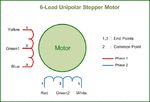kavinuma
Newbie level 1
Hi,
I am a beginner n00bzorz with circuits, and for this project I'm working on, it was recommended that I use a stepper motor for its precise rotation. So I bought a stepper motor, but I have absolutely no idea how to use it. It's a 4 phase 5 wire lead stepper motor, which looks a lot like this:
https://www.geeetech.com/wiki/index...ase_5-Wire_&_ULN2003_Driver_Board_for_Arduino
I don't know how to hook it up, and I don't know how to operate it at all. Our project was originally complex, but we have dumbed it down considerably. We are using an electrical signal from the eye (EOG https://en.wikipedia.org/wiki/Electrooculography) to control a prosthetic eye to rotate synchronously. We are only working with left and right movements and it's pretty much three positions for the eye: left, right, and middle. So what I need to do is use the right movement output to rotate the stepper motor let's say 70 degrees and the left 70 degrees the other way. But again, I have no idea what I am doing. If anyone can help, I would greatly appreciate it.
- kavinuma
I am a beginner n00bzorz with circuits, and for this project I'm working on, it was recommended that I use a stepper motor for its precise rotation. So I bought a stepper motor, but I have absolutely no idea how to use it. It's a 4 phase 5 wire lead stepper motor, which looks a lot like this:
https://www.geeetech.com/wiki/index...ase_5-Wire_&_ULN2003_Driver_Board_for_Arduino
I don't know how to hook it up, and I don't know how to operate it at all. Our project was originally complex, but we have dumbed it down considerably. We are using an electrical signal from the eye (EOG https://en.wikipedia.org/wiki/Electrooculography) to control a prosthetic eye to rotate synchronously. We are only working with left and right movements and it's pretty much three positions for the eye: left, right, and middle. So what I need to do is use the right movement output to rotate the stepper motor let's say 70 degrees and the left 70 degrees the other way. But again, I have no idea what I am doing. If anyone can help, I would greatly appreciate it.
- kavinuma
